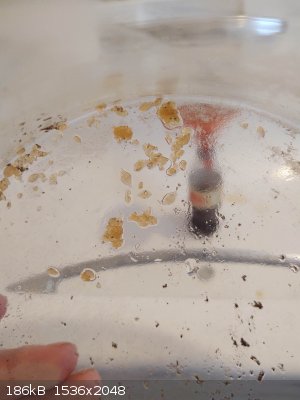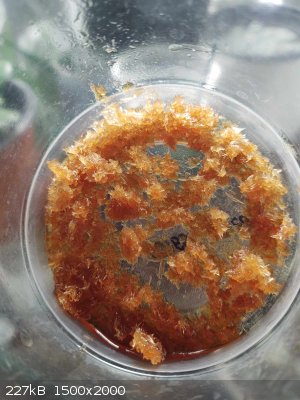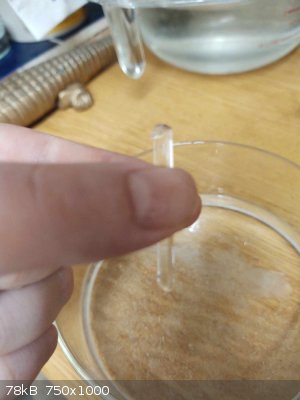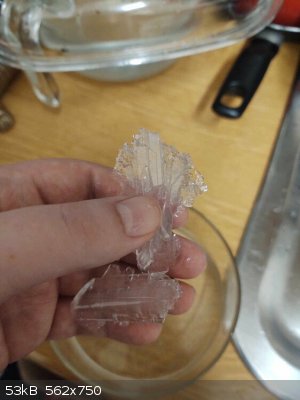| Pages:
1
2
3 |
Romix
Hazard to Others (Literally)
  
Posts: 483
Registered: 19-6-2015
Member Is Offline
Mood: No Mood
|
|
First rhombus shaped crystals appeared!
[Edited on 16-8-2023 by Romix]

|
|
|
averageaussie
Hazard to Self
 
Posts: 92
Registered: 30-4-2023
Location: Right behind you
Member Is Offline
Mood: school 
|
|
looks good!
are you planning on doing a recrystallisation, or use them as is?
|
|
|
Romix
Hazard to Others (Literally)
  
Posts: 483
Registered: 19-6-2015
Member Is Offline
Mood: No Mood
|
|
This first crystals might not be what I want, they not dissolving in water, don't need to recrystallize them, rinsing with water is enough for them.
Chucked them in a cactus pot. If similar crystals will form again doing plant ash, I might start collecting them. Might need to evaporate solution bit
more.
|
|
|
averageaussie
Hazard to Self
 
Posts: 92
Registered: 30-4-2023
Location: Right behind you
Member Is Offline
Mood: school 
|
|
Quote: Originally posted by Romix  |
This first crystals might not be what I want, they not dissolving in water, don't need to recrystallize them, rinsing with water is enough for them.
Chucked them in a cactus pot. If similar crystals will form again doing plant ash, I might start collecting them. Might need to evaporate solution bit
more. |
Do you know what the crystals are?
|
|
|
Romix
Hazard to Others (Literally)
  
Posts: 483
Registered: 19-6-2015
Member Is Offline
Mood: No Mood
|
|
Quote: Originally posted by averageaussie  | Quote: Originally posted by Romix  |
This first crystals might not be what I want, they not dissolving in water, don't need to recrystallize them, rinsing with water is enough for them.
Chucked them in a cactus pot. If similar crystals will form again doing plant ash, I might start collecting them. Might need to evaporate solution bit
more. |
Do you know what the crystals are? |
Don't have a clue. Do you?
|
|
|
Romix
Hazard to Others (Literally)
  
Posts: 483
Registered: 19-6-2015
Member Is Offline
Mood: No Mood
|
|
Evaporated solution for 2 more hours on a lamp, lots of small crystals formed on cooling and they grow quite fast.
Ok, will let them grow till last 30 - 40 ml of black solution left in a dish.
I have a can of Potassium Carbonate Anhydrous, 99% pure, will crystalize sample of it too, to compare if crystals look the same.
Also will test with weak nitric for Potassium.
[Edited on 18-8-2023 by Romix]
|
|
|
Romix
Hazard to Others (Literally)
  
Posts: 483
Registered: 19-6-2015
Member Is Offline
Mood: No Mood
|
|
Quote: Originally posted by Romix  | I can dissolve it all in vinegar, drop everything out of the solution with KOH, add Phosphoric acid to the precipitate and make slow release
fertilizer, that can be mixed with the soil in a pots and be absorbed by the plant roots very very slowly with every watering because of it's low
solubility. Think it will be good for potatoes.
But I want to gain more knowledge of plant ash and separate it in to mono atomic salts, don't know how to, though. |
This method won't work, because most of the hydroxides dissolves in excess KOH. Works ok with K2CO3, just tried it. Waiting for hydroxides that didn't
dissolve in excess KOH to finish filtering, then going to acidify solution with acetic acid, and drop out carbonates.
|
|
|
Romix
Hazard to Others (Literally)
  
Posts: 483
Registered: 19-6-2015
Member Is Offline
Mood: No Mood
|
|
K2CO3 crystals!
[Edited on 20-8-2023 by Romix]

|
|
|
averageaussie
Hazard to Self
 
Posts: 92
Registered: 30-4-2023
Location: Right behind you
Member Is Offline
Mood: school 
|
|
those are quite the crystals!
are these the same as the dirtier crystals from earlier?
|
|
|
Romix
Hazard to Others (Literally)
  
Posts: 483
Registered: 19-6-2015
Member Is Offline
Mood: No Mood
|
|
No, 99% pure K2CO3. Dissolved 250 grams in 250ml of boiling water in a morning, left on a lamp to evaporate through the day, before going to bed took
them of the lamp and they grew over 1 night. This are very soluble, first dirtier crystals were completely insoluble, what came after them still
growing, can't capture them with my phone camera, but I can see more rhombus shaped ones in there.
[Edited on 21-8-2023 by Romix]
|
|
|
Romix
Hazard to Others (Literally)
  
Posts: 483
Registered: 19-6-2015
Member Is Offline
Mood: No Mood
|
|
Doubt that water soluble plant ash mainly is K2CO3.
Because K2CO3 makes your hands soupy, water soluble plant ash doesn't...
And solubility completely different!
[Edited on 21-8-2023 by Romix]
|
|
|
B(a)P
International Hazard
    
Posts: 1139
Registered: 29-9-2019
Member Is Offline
Mood: Festive
|
|
Quote: Originally posted by Romix  | Doubt that water soluble plant ash mainly is K2CO3.
Because K2CO3 makes your hands soupy, water soluble plant ash doesn't...
And solubility completely different!
[Edited on 21-8-2023 by Romix] |
It would also contain phosphates.
|
|
|
averageaussie
Hazard to Self
 
Posts: 92
Registered: 30-4-2023
Location: Right behind you
Member Is Offline
Mood: school 
|
|
would there be any nitrates in there?
|
|
|
B(a)P
International Hazard
    
Posts: 1139
Registered: 29-9-2019
Member Is Offline
Mood: Festive
|
|
Unlikely, nitrates decompose at pretty low temperatures.
|
|
|
Romix
Hazard to Others (Literally)
  
Posts: 483
Registered: 19-6-2015
Member Is Offline
Mood: No Mood
|
|
https://www.youtube.com/shorts/CDHhV_JjUq8
Don't know if you can see it in my video? I can, slight violet in there. Potassium Carbonate also present as impurity and spoon was soapy after doing
the experiment, but orange has the advantage!!! So I think first crystals that came out of solution are Sodium Acetate. This is insoluble in water
plant ash dissolved in vinegar, then hydroxides been precipitated with KOH, I've noticed that some of the precipitate is dissolving in excess of KOH,
after filtering I've reacidified it again with vinegar and dropped what dissolved in excess of KOH with K2CO3. Don't know where Sodium came from,
maybe from the plant ash or could be from 10% impurities of KOH. It's definitely Acetate, because it decomposed on a spoon to Carbon, also orange
color of a flame takes advantage! And solubility about right, Sodium have the lowest solubility of an alkali metal group Acetates.
[Edited on 23-8-2023 by Romix]
|
|
|
Romix
Hazard to Others (Literally)
  
Posts: 483
Registered: 19-6-2015
Member Is Offline
Mood: No Mood
|
|
Flame is more visible here. filmed in the dark, same Acetate...
https://www.youtube.com/watch?v=bgu1FtHCI64&t=53s
|
|
|
Romix
Hazard to Others (Literally)
  
Posts: 483
Registered: 19-6-2015
Member Is Offline
Mood: No Mood
|
|
That's how water soluble plant ash crystalizes.
[Edited on 4-9-2023 by Romix]

|
|
|
Romix
Hazard to Others (Literally)
  
Posts: 483
Registered: 19-6-2015
Member Is Offline
Mood: No Mood
|
|
1L of 10% vinegar yielded 50 grams of minerals out of plant ash with water soluble salts removed before treating it with vinegar.
What dissolved in excess KOH and what stayed as Hydroxide turning grey on air drying from white is combined.
Calcium Hydroxide is dissolving in KOH solution well, tested the precipitate...
New laws came out in UK few days ago, only businesses and people with licenses are allowed to buy concentrated HCl and H3PO4. 10% HCl still available
for anyone at 1.2£ per L, might try dissolving plant ash in it too, works out cheaper then using vinegar. Can't find H3PO4 under 30% concentration,
and I will need it to make fertilizer.
[Edited on 8-10-2023 by Romix]

|
|
|
Romix
Hazard to Others (Literally)
  
Posts: 483
Registered: 19-6-2015
Member Is Offline
Mood: No Mood
|
|
That is how this needle like crystals of water soluble plant ash look like when they grow bigger.
I've evaporated off their water of crystallization on a hot plate,
Then burned off all the impurities that colored the solution brown in a stainless steel crucible with MAPP torch. Look on a color of the flame, this
is not Potassium salt as people say on internet. To me it looks more like Sodium, Calcium is more orangy.
Then after incineration of this salt, I've dissolved it in boiling water and filtered oxidation products of crucible that stack to the salt.
Solution is clear now, completely colorless. My expectations were met!
Now I'm evaporating this solution on a top of my LED lamp slowly, down to formation of first crystals.
  
[Edited on 15-10-2023 by Romix]
|
|
|
Romix
Hazard to Others (Literally)
  
Posts: 483
Registered: 19-6-2015
Member Is Offline
Mood: No Mood
|
|
Water soluble plant ash, you saw how it starts crystalizing as a single crystal and what it looks like when crystals gets bigger.
All the crystals were the same, needle like shaped. Color of a flame test is orangy yellow. Not decomposing at temperatures over 1000 C, only starting
to melt. Any ideas what the substance is??? Or maybe advices on further tests that can be done to identify it?
[Edited on 15-10-2023 by Romix]
|
|
|
Rainwater
National Hazard
   
Posts: 937
Registered: 22-12-2021
Member Is Offline
Mood: Break'n glass & kick'n a's
|
|
At that temperature its likely an oxide of sodium + what your can is made of.
By heating directly with a flame you introduce conbustion products.
Na2O with a carbonate contamination is what I think you got.
Exposure to co2 or water will generate carbonate and hydroxide
Your reagent should not be heated directly with a flame, and be protected from air and moisture at all times to preserve it for testing.
Tip: dont let your can touch anything as you heat it. The point if contact will suck the heat out as fast as you can push it in. A small bit of
firewool helps save fuel.
Test 1)
record the temperature and ph of about 10ml of household vinegar.
Insert a piece of your product.
Record temperature and ph change.
Note if bubbles form, how many. (2 per second, 20 per second. Did they last until the solid was disolved)
It may be nessacery to crush the piece to increase the reaction rate.
Extract sodium metal.
If no/few bubbles formed, you do not have a carbonate or its only a contamination
Use your product to replace sodium hydroxide in this procedure
Nerdrage Make Sodium Metal with Menthol (and a bunch of other stuff...)
That will prove beyond any dought what you have.
I have used freshly made Na2O for this reaction to see if it had an effect on the reaction rate. It still takes 3-4 days to finish.
"You can't do that" - challenge accepted
|
|
|
Romix
Hazard to Others (Literally)
  
Posts: 483
Registered: 19-6-2015
Member Is Offline
Mood: No Mood
|
|
Did another batch, what's left in a crystalizing dish 110ml of concentrated water soluble plant ash, after all crystals been removed and incinerated.
Check the video out. Flames coming out of the crucible are violet. Is this a sign of Potassium presence in what's left.
https://www.youtube.com/shorts/quB1TzTOeGE
|
|
|
Hexabromobenzene
Hazard to Others
  
Posts: 128
Registered: 27-4-2021
Member Is Offline
|
|
I leached more 100 kg different plant ashes for many years. Mainly trees. Average soluble salt content about 5%. Main salt is potash with potassium
sulfate which precipitates during evaporation
|
|
|
Romix
Hazard to Others (Literally)
  
Posts: 483
Registered: 19-6-2015
Member Is Offline
Mood: No Mood
|
|
After incineration shape of the crystals changed!!
|
|
|
Romix
Hazard to Others (Literally)
  
Posts: 483
Registered: 19-6-2015
Member Is Offline
Mood: No Mood
|
|
Mono K2SO4 crystal.  I think it's Potassium Sulphate... I think it's Potassium Sulphate...
Here's how I made it, dissolved full plastic cup of MgSO4·7H2O in boiling water and added about 5 table spoons of KOH to it , maybe a bit more then
that, can't remember, added it until the PH turned slightly basic, less then almost insoluble Ca(OH) colors litmus blue.
Might it not be K2SO4?
[Edited on 26-11-2023 by Romix]
 
|
|
|
| Pages:
1
2
3 |